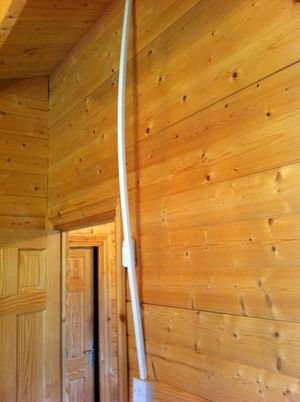Fixing Shelves, Furniture & Equipment to Log Cabin Walls – The Do’s and Don’ts
With log cabins, the individual wall logs will change in height slightly dependant on moisture content of the wood. Because there are several wall logs in the height of the wall, there will be an accumulative growth or shrinking of the wall height which could be +/- 20 mm. This is normal behaviour and allowed for in log cabin design.
In the picture you will see a good example of what we mean by the natural movement of the wall height. When our cabin was first built, the electrical conduit was cut to fit and lay flush against the wall. Over time each log has shrunk, causing shrinking of the wall height and causing the plastic to bow out. We’ve left it like this as it is a good example to refer to when explaining the concept to our customers.
* “Equipment” can cover pipework, wall battens for cladding, electrical trunking, shower units, tiling and trellis etc.
However the attachment of other furniture or equipment to cabin walls needs to be done with care to make allowance for such movements. To ignore the natural rise and fall of the wall by incorrectly fitting furniture or *equipment can cause gaps to appear in the wall or can cause damage to the furniture or equipment. If a mirror is fitted directly to the wall with top and bottom fixings and then the wall shrinks in height the mirror tries to bow away from the wall and you end up with two mirrors!
There are several methods of installing shelves or cabinets or mirrors etc to log cabin walls:-
If you wish to fit shelves to the wall logs with brackets that only cross one or two logs, that is fine to do so.
If your shelving unit is free standing on the floor, it is bad practice to fix it rigidly to the walls at the top. This would hold the wall log in position whilst the wall logs below it might all shrink a little and would cause a gap in the wall.
If it is necessary to prevent over turning of the unit, it would be better to fix the unit to the wall with a flexible braid or wire that allows the walls to rise and fall naturally but resists any tendency for the unit to fall away far from the wall.
If the shelf unit is long and does not touch the floor it is ok to fix it at the top and let it hang. It would not be suitable to fix it at the bottom as well.
If it really is necessary to fix top and bottom then the correct method is to firstly attach a vertical batten to the wall, using one of our sliding bracket systems.

